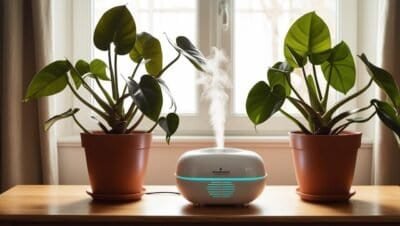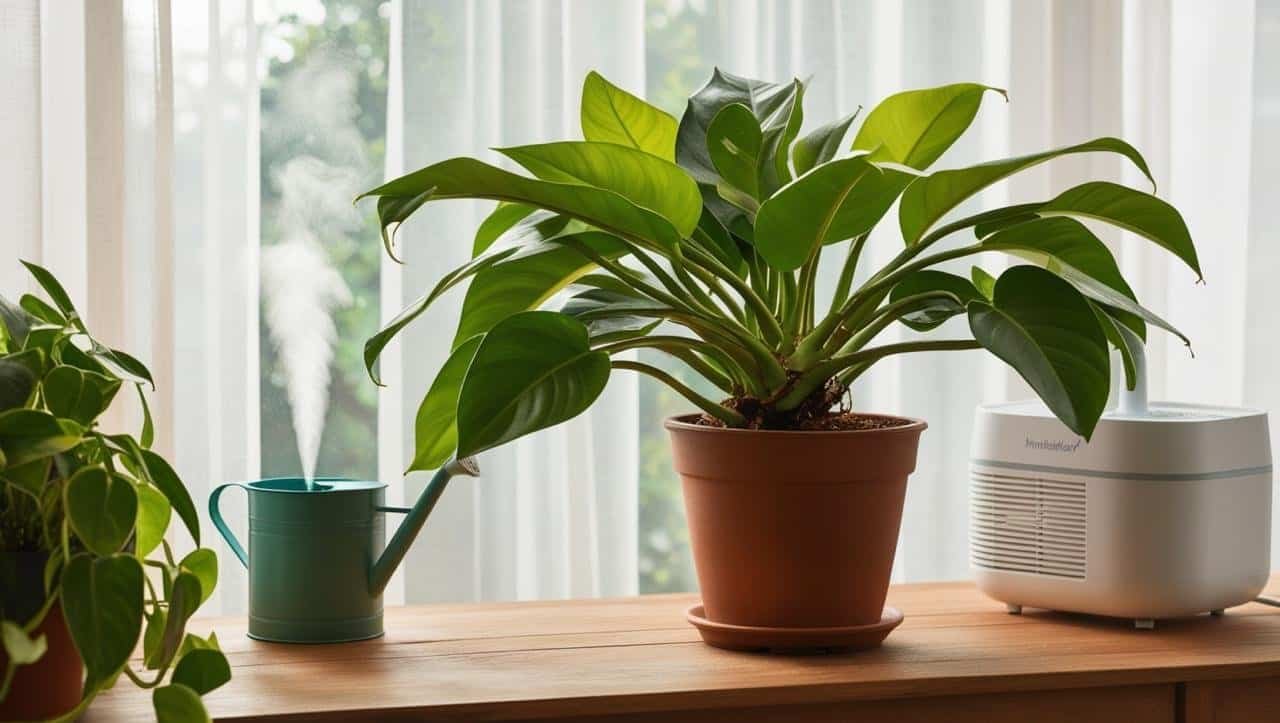Have you noticed your philodendron’s leaves curling up? You’re not the only one dealing with this issue. Curling leaves often mean the plant needs some extra care. Common causes are over watering that leads to root rot or low humidity stressing it out. We’ll explain the usual suspects behind curled leaves and how to care for your philodendron so it stays happy and healthy.
Key Takeaway
- Curling leaves can indicate issues like overwatering, underwatering, or low humidity.
- Regularly check the top inch of soil to determine when to water your plant.
- Providing proper light and humidity levels is essential for healthy philodendron leaves.
Common Causes of Curling Leaves
It’s common for philodendro leaves to curl up sometimes. Here are a few usual suspects:
- Too Much or Too Little Water: Underwatering makes leaves curl up to save moisture. Overwatering can cause roots to rot, which stops nutrients from getting to leaves.
- Light Level Issues: These plants like bright, indirect light. Not enough light means leaves curl trying to reach the source. Too much direct sun can scorch leaves though.
- Temperature Swings: Big changes in temperature from day to night or between indoors and outdoors stresses philodendrons. Leaves respond by curling until things even out.
- Fertilizer Problems: Too much or too little plant food can disrupt things. Leaves may curl as the plant struggles with an imbalance.
If leaves are otherwise green and healthy, don’t worry too much. Small adjustments to water, light or care should straighten things out. Let me know if problems persist!(1)
Temperature and Humidity

The temperature around philodendrons needs to stay steady between 65-80°F for them to feel their best. Sudden changes can throw them off:
- Drafty Spots: Blowing air from vents or windows stresses these plants, making leaves curl up.
- Dry Air: Philodendrons love humidity but struggle when it’s too dry. Their leaves may respond by folding in on themselves.
- Solutions for Dryness: A humidifier adds moisture to the air. You can also mist leaves frequently by hand. Both help the plant stay hydrated and comfortable.
Remember, curled leaves often mean something is off with water, light, temperature or humidity. With a little tweaking of conditions, you can have your philodendron looking healthy and happy again in no time. Let me know if you need any other care tips!
Identifying the Problem
Take a close look at how the leaves are curling to get clues. Uniform curling may just be normal growth, but check further if:
- Only Some Curl: Wilted or discolored leaves mean something’s off.
- Different Curling: Irregular patterns point to environmental problems.
Paying attention to small details helps solve leaf-curling mysteries!
Watering Practices
Having a regular water plan keeps your philodendron perky. Some tips:(2)
- Check Soil Moisture: Water when the top inch is dry to avoid over-or under-watering.
- Watch for Dew Drops: Tiny water beads on leaves are normal guttation, not a problem.
Sticking to a watering routine and monitoring for issues ensures your plant’s leaves stay flat and fabulous for long! Let me know if any other questions come up.
Humidity Management
philodendrons love humadity just like the tropical places they come from. Here are some simple hacks:
- Group Plants: Putting your philodendron near other green buddies makes a more humid hangout spot.
- Use a Humidifier: These appliances add moisture back into the air to make your plant pal happy.
- Mist Leaves: Lightly spritzing foliage with water helps leaves stay hydrated. Just be gentle – too much and leaves get soggy!
Paying a little extra attention to humidity goes a long way for your philodendron’s health and good looks. Let me know if you have any other questions!
Light Exposure
Light is key for philodendrons to stay healthy and good looking. Here are some tips:
- Bright Indirect Sun: Place your plant where it gets lots of filtered sunlight to power strong growth.
- Avoid Direct Rays: Harsh sunlight can scorch leaves, so keep your plant out of intense sunbeams.
- Watch for Stretching: If leaves start reaching extra high, it may need more light exposure.
Paying attention to your plant’s light needs ensures it looks lush and leafy for a long time!
Nutrient Needs
Feeding your philodendron regularly provides the nutrients it loves. Try this:
- Use Balanced Plant Food: During spring and summer, fertilize occasionally with an all-purpose formula.
- Check for Deficiency Signs: Curled leaves could mean it’s not getting what it needs to thrive – adjust food or light.
With proper light, water, humidity and nutrients, your philodendron will stay in tip-top shape for years of enjoyment! Let me know if any other questions come up.
Signs of Distress
Keep an eye out so small issues don’t become big problems. Warning signs include:
- Curling and Yellowing Leaves: This could mean overwatered soil or root rot from soggy conditions.
- Check the Drainage: Make sure water can easily drain out the bottom and not sit in the soil.
- Ensure the Right Soil: The potting mix needs to balance moisture retention and drainage.
Nipping potential problems in the bud helps your philodendron stay in tip-top shape!
Prevention Tips
With just a little regular TLC, your philodendron will be in leafy heaven. Try these preventative measures:
- Stick to a Watering Schedule: Check the soil moisture so it never gets too soggy or dry.
- Improve Drainage: Use a well-draining potting mix to avoid root rot issues.
- Boost Humidity: Mist leaves or use a humidifier, especially in drier homes.
- Use Filtered Water: Tap water deposits can harm plants over time.
- Prune Periodically: Trim away any yellow or wilted foliage to encourage new growth.
Small efforts go a long way towards a healthy, happy philodendron! Let me know if you have any other questions.
Conclusion
Proper soil is key for philodendron health. Use a well-draining potting mix to prevent overwatering issues. Add compost or perlite to improve drainage if needed. Check the soil moisture level before watering. By sticking to a schedule, you keep your plant happy without risking root problems.
FAQ
What causes philodendron leaves curling and turning yellow, and how can I check the soil for excess moisture?
Philodendron leaves curling can be caused by several factors, including root rot and excess moisture in the potting mix. To check the soil, feel the top inch of soil; if it feels dry, it may be time to water your plant. Look for signs of overwatering, like yellowing leaf tips, which can indicate that your indoor plant is struggling.
How does humidity affect philodendron care, and what should I do if my indoor plants have water droplets on leaves?
High humidity levels can benefit philodendron plants, as they thrive in moist environments. If you notice water droplets on leaves, this is called guttation, a natural process where plants release water. Ensure good air circulation and maintain proper moisture levels to keep your house plants healthy.
Why are my philodendron leaves dripping water, and what does it mean when plants release water?
When philodendron leaves are dripping water, it often means the plant is experiencing transpiration and guttation. This occurs when humidity levels are high, and the plant releases excess water through hydathodes. Monitor your watering schedule and ensure your potting mix has drainage holes to prevent root rot.
How can I improve the light conditions for my philodendron plant to prevent curling leaves?
To prevent curling leaves, ensure your philodendron plant receives adequate light conditions. Place it in a spot with bright, indirect sunlight. If the temperature drops or light levels are too low, the plant may struggle, leading to curling leaves. Adjust your plant care routine accordingly.
What are the unique characteristics of philodendron scandens, and how do they relate to leaf curling?
Philodendron scandens, like other philodendron plants, can exhibit unique characteristics such as aerial roots and heart-shaped green leaves. If the leaves start curling, it may indicate issues like excess water or low humidity. Regularly check the soil and adjust your watering schedule to maintain healthy moisture levels.
References
- https://bloomscape.com/common-issue/why-are-my-philodendrons-leaves-curling/
- https://philodendrontalk.com/philodendron-leaves-curling/
Related Article
- https://knowngarden.com/mccolleys-finale-philodendron/
- https://knowngarden.com/brazil-philo/#google_vignette
- https://knowngarden.com/philodendron-birkin/

